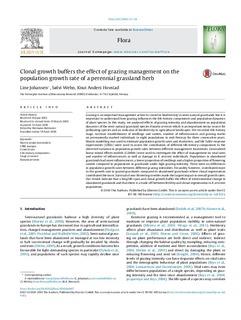| dc.contributor.author | Johansen, Line | |
| dc.contributor.author | Wehn, Sølvi | |
| dc.contributor.author | Hovstad, Knut | |
| dc.date.accessioned | 2017-12-18T11:16:31Z | |
| dc.date.available | 2017-12-18T11:16:31Z | |
| dc.date.created | 2016-10-25T09:44:33Z | |
| dc.date.issued | 2016-04-19 | |
| dc.identifier.citation | Flora: Morphologie, Geobotanik, Oekophysiologie. 2016, 223 11-18. | nb_NO |
| dc.identifier.issn | 0367-2530 | |
| dc.identifier.uri | http://hdl.handle.net/11250/2472432 | |
| dc.description.abstract | Grazing is an important management action to conserve biodiversity in semi-natural grasslands but it is important to understand how grazing influences the life-history components and population dynamics of plant species. In this study, we analysed effects of grazing intensity and abandonment on population dynamics of the semi-natural grassland species Knautia arvensis which is an important nectar source for pollinating species and an indicator of biodiversity in agricultural landscapes. We recorded life-history stage, survival, establishment of seedlings and ramets, number of inflorescences and grazing marks on permanently marked individuals in eight populations in mid-Norway for three consecutive years. Matrix modelling was used to estimate population growth rates and elasticities, and life Table response experiments (LTREs) were used to assess the contribution of different life-history components to the observed variation in population growth rates between different management treatments. Generalized linear mixed effects models (GLMMs) were used to investigate the effect of management on vital rates and number of inflorescences as well as damage to K. arvensis individuals. Populations in abandoned grasslands had more inflorescences, a lower proportion of seedlings and a higher proportion of flowering ramets compared to populations in grasslands under high grazing intensity. There were no differences in population growth rates between different grazing intensities. Fecundity however, contributed more to the growth rate in grazed grasslands compared to abandoned grasslands where clonal regeneration contributed the most. Survival of non-flowering rosettes made the largest impact to overall growth rates. Our results indicate that a long life-span and clonal growth buffer the effect of environmental change in abandoned grasslands and that there is a trade-off between fertility and clonal regeneration in K. arvensis populations. | nb_NO |
| dc.language.iso | eng | nb_NO |
| dc.publisher | Elsevier | nb_NO |
| dc.rights | Attribution-NonCommercial-NoDerivatives 4.0 Internasjonal | * |
| dc.rights.uri | http://creativecommons.org/licenses/by-nc-nd/4.0/deed.no | * |
| dc.title | Clonal growth buffers the effect of grazing management on the population growth rate of a perennial grassland herb | nb_NO |
| dc.type | Journal article | nb_NO |
| dc.type | Peer reviewed | nb_NO |
| dc.description.version | publishedVersion | nb_NO |
| dc.rights.holder | © 2016 The Author(s). Published by Elsevier GmbH. | nb_NO |
| dc.source.pagenumber | 11-18 | nb_NO |
| dc.source.volume | 223 | nb_NO |
| dc.source.journal | Flora: Morphologie, Geobotanik, Oekophysiologie | nb_NO |
| dc.identifier.doi | 10.1016/j.flora.2016.04.007 | |
| dc.identifier.cristin | 1394265 | |
| dc.relation.project | EC/FP7/244983 | nb_NO |
| dc.relation.project | Norges forskningsråd: 208036 | nb_NO |
| cristin.ispublished | true | |
| cristin.fulltext | original | |
| cristin.qualitycode | 1 | |

